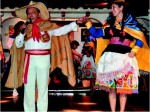
Monthlong observance commemorates culture The National Hispanic Heritage Month is a celebration of the culture and traditions of U.S. residents who trace their roots to Spain, Mexico and the Spanish-speaking nations of Central America, South America and the Caribbean. It is a month-long celebration (Sept. 15-Oct. 15) and this year’s theme is "Hispanic Americans: Our Rich Culture Contributing to America’s Future." Sept. 15 was chosen as the starting point for the celebration because it is the anniversary of independence of five Latin American countries: Costa Rica, El Salvador, Guatemala, Honduras and Nicaragua. In addition, Mexico and Chile celebrate their independence days on Sept. 16 and Sept. 18, respectively. What does Hispanic mean? The word Hispanic is actually a cultural or ethnic term. The Department of Defense Directive 1350.2 defines Hispanic as "a person having origins in any of the original peoples of Mexico, Puerto Rico, Cuba, Central or South America, or of other Spanish cultures, regardless of race." The term Hispanic is not the only title used to describe this segment of society. In the Western United States, many prefer the term Latino. Latinos (Latina for females) are people of Latin American origin living in the United States. When speaking of individuals of Mexican ancestry, one might use Mexican-American to mean any person of Mexican origin living in the U.S. That same person, if living in Texas, might prefer to be described as a Tejano or Texan. The term Chicano (Chicana for women) is defined as an American of Mexican descent. This term is used especially in the Mexican American community, but the more accepted terms are Hispanic or Latino. Although the term Hispanic may be oversimplifying, different variables divide de Hispanic population, such as race, Hispanics can be classified into any race category from white to black. The language some Hispanics speak is only English, some speak only Spanish, and others are bilingual; Time of arrival, such as, first, second and third generations; and National origin; which means that they relate to the area where they are from, such as Puerto Rico, Mexico, Cuba, or Honduras. The term Hispanic refers to approximately 30 different nationalities, and it was chosen by the United States government, not the people of Spanish heritage themselves. History of Hispanics October 12, 1492 is the El DAŸ_a de la Raza (The Day of the Race), date of origin for Hispanics. On that day Christopher Columbus landed in the Antilles and began the mixing of Europeans, indigenous Americans, and Africans. Historians credit Spain for the total discovery, exploration, and colonization of the western hemisphere. Nowhere in the history of the human race has this ever occurred. Exploration and Colonization stages lasted from 1492 to 1542. During the period of exploration, in one generation, approximately 300,000 Spaniards had migrated to the New World. They established over 200 cities and towns throughout America. From exploring to colonizing the West; from the most southern tip of South America to most of North America; chartered the oceans, islands, criss-crossing America by foot, raft, ship, & by horse, & in one generation Hispanics acquired more new territory than Rome conquered in five centuries. Brief USA Hispanics history The history of Hispanics in the United States precedes the American Revolution. As early as 1526, there were Spanish settlers in what is now the continental United States. In fact, the oldest city in the United States is St. Augustine, Fla. founded in 1565. The founder of St. Augustine, Pedro Menendez de Aviles, and his Spanish fleet arrived off the coast of Florida on August 28, 1565, the Feast Day of St. Augustine. Today the estimated Hispanic population of the United States as of July 1, 2005, was 42.7 million, making people of Hispanic origin the nation’s largest ethnic or race minority. Hispanics constituted 14 percent of the nation’s total population. California is home to 12.4 million Hispanics, and Texas is home to 7.8 million. Sixty-four percent of Hispanic-origin people in households are of Mexican background. Approximately 10 percent are of Puerto Rican background, with about three percent each of Cuban, Salvadoran and Dominican origins. The remainder is of some other Central American, South American or other Hispanic or Latino origins. Ten million of them were born in Mexico by far more than any other Latin American country or any other country in the world for that matter. Other countries of birth that contribute large numbers of Hispanics are El Salvador (937,000), Cuba (925,000), the Dominican Republic (688,000), Guatemala (590,000) and Colombia (500,000). Thirteen states have at least half a million Hispanic residents. These states are: Arizona, California, Colorado, Florida, Georgia, Illinois, Nevada, New Jersey, New Mexico, New York, North Carolina, Texas and Washington. Forty-three percent of New Mexico’s population is Hispanic, highest of any state. Hispanics also make up more than one-third of the population in California and Texas, at 35 percent each. The Hispanic population of Los Angeles County, Calif. is 4.6 million, the largest of any county in the nation. Hispanics have blended into American society, bringing their culture, traditions, religion, food and language with them. If population predictions hold, they will continue to contribute a greater role in our country’s future.
